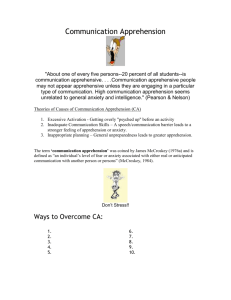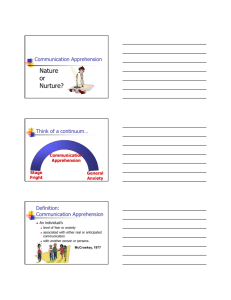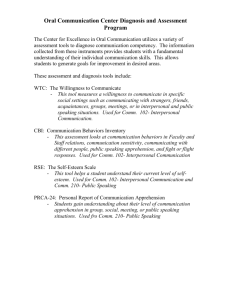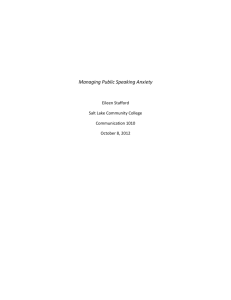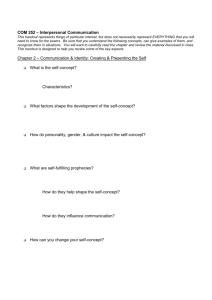Communication Apprehension among First
advertisement
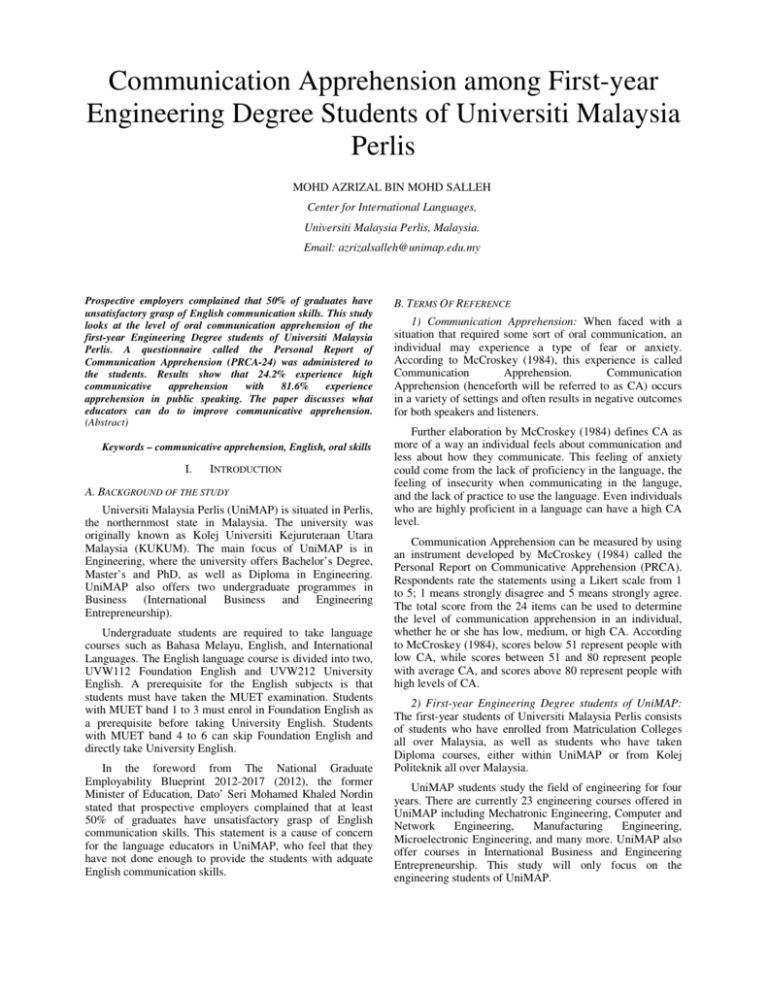
Communication Apprehension among First-year Engineering Degree Students of Universiti Malaysia Perlis MOHD AZRIZAL BIN MOHD SALLEH Center for International Languages, Universiti Malaysia Perlis, Malaysia. Email: azrizalsalleh@unimap.edu.my Prospective employers complained that 50% of graduates have unsatisfactory grasp of English communication skills. This study looks at the level of oral communication apprehension of the first-year Engineering Degree students of Universiti Malaysia Perlis. A questionnaire called the Personal Report of Communication Apprehension (PRCA-24) was administered to the students. Results show that 24.2% experience high communicative apprehension with 81.6% experience apprehension in public speaking. The paper discusses what educators can do to improve communicative apprehension. (Abstract) Keywords – communicative apprehension, English, oral skills I. INTRODUCTION A. BACKGROUND OF THE STUDY Universiti Malaysia Perlis (UniMAP) is situated in Perlis, the northernmost state in Malaysia. The university was originally known as Kolej Universiti Kejuruteraan Utara Malaysia (KUKUM). The main focus of UniMAP is in Engineering, where the university offers Bachelor’s Degree, Master’s and PhD, as well as Diploma in Engineering. UniMAP also offers two undergraduate programmes in Business (International Business and Engineering Entrepreneurship). Undergraduate students are required to take language courses such as Bahasa Melayu, English, and International Languages. The English language course is divided into two, UVW112 Foundation English and UVW212 University English. A prerequisite for the English subjects is that students must have taken the MUET examination. Students with MUET band 1 to 3 must enrol in Foundation English as a prerequisite before taking University English. Students with MUET band 4 to 6 can skip Foundation English and directly take University English. In the foreword from The National Graduate Employability Blueprint 2012-2017 (2012), the former Minister of Education, Dato’ Seri Mohamed Khaled Nordin stated that prospective employers complained that at least 50% of graduates have unsatisfactory grasp of English communication skills. This statement is a cause of concern for the language educators in UniMAP, who feel that they have not done enough to provide the students with adquate English communication skills. B. TERMS OF REFERENCE 1) Communication Apprehension: When faced with a situation that required some sort of oral communication, an individual may experience a type of fear or anxiety. According to McCroskey (1984), this experience is called Communication Apprehension. Communication Apprehension (henceforth will be referred to as CA) occurs in a variety of settings and often results in negative outcomes for both speakers and listeners. Further elaboration by McCroskey (1984) defines CA as more of a way an individual feels about communication and less about how they communicate. This feeling of anxiety could come from the lack of proficiency in the language, the feeling of insecurity when communicating in the languge, and the lack of practice to use the language. Even individuals who are highly proficient in a language can have a high CA level. Communication Apprehension can be measured by using an instrument developed by McCroskey (1984) called the Personal Report on Communicative Apprehension (PRCA). Respondents rate the statements using a Likert scale from 1 to 5; 1 means strongly disagree and 5 means strongly agree. The total score from the 24 items can be used to determine the level of communication apprehension in an individual, whether he or she has low, medium, or high CA. According to McCroskey (1984), scores below 51 represent people with low CA, while scores between 51 and 80 represent people with average CA, and scores above 80 represent people with high levels of CA. 2) First-year Engineering Degree students of UniMAP: The first-year students of Universiti Malaysia Perlis consists of students who have enrolled from Matriculation Colleges all over Malaysia, as well as students who have taken Diploma courses, either within UniMAP or from Kolej Politeknik all over Malaysia. UniMAP students study the field of engineering for four years. There are currently 23 engineering courses offered in UniMAP including Mechatronic Engineering, Computer and Network Engineering, Manufacturing Engineering, Microelectronic Engineering, and many more. UniMAP also offer courses in International Business and Engineering Entrepreneurship. This study will only focus on the engineering students of UniMAP. These first-year students have taken the Malaysian University English Test (MUET). Students who achieved MUET band 1 to 3 must enrol in Foundation English course, and students who achieved MUET band 4 to 6 can skip Foundation English and take the second level of English, which is University English. 120 students. This results in a small number of respondents and does not represent a significant number from the total number of students. C. PROBLEM STATEMENT According to McCroskey (1984), communication apprehension is defined as a level of fear or anxiety that a person has when engaging or anticipating in communication. When a person experiences communication apprehension, he or she is unable to communicate effectively. McCroskey described a person experiencing CA as being afraid to communicate and as a result, stayed quiet as a sign to avoid what they fear the most. Communication Apprehension can also be called stage fright or performance anxiety. In a Foundation English classroom, it can be observed that students did not attempt to communicate using the English Language. The problem is amplified when the students are instructed to give presentations in front of the class. An informal interview with the students has revealed that a sense of anxiety has overcome the students. So far, there has been limited research on communication apprehension in the Malaysian education landscape, specifically in the domain of engineering. One research by Huwari (2010) looks at CA among Jordanian postgraduate students in UUM. Another research by Foo (2011) looks at CA among Malaysian accounting students. Another research on CA was done by Wan Zumusni (2010) towards Business Administration (BBA) students. This research may fill the gap in understanding the problem of communicative apprehension, specifically in the domain of engineering education. D. RESEARCH OBJECTIVE The objective of this research is to identify the level of communication apprehension among the first-year engineering students in Universiti Malaysia Perlis. E. RESEARCH QUESTION What is the level of communication apprehension among the first year engineering students of Universiti Malaysia Perlis? F. SIGNIFICANCE OF RESEARCH The findings from this study is hoped to shed a light on the issue of communication apprehension in UniMAP. The findings of this research can help language instructors of UniMAP to identify the strengths and weaknesses in their teaching methods. The findings will help the language instructors in the development of a better language instruction that can reduce communication apprehension in UniMAP. II. LITERATURE REVIEW According to Huwari (2010), an individual with a high level of communication apprehension are less likely to engage in communication than an individual with a low level of CA. Additionally, an individual with a high CA is viewed negatively by others. This negative view includes a preconception that the speaker (with high CA) is weak in oral communication. According to Wan Zumusni (2010), individuals with high CA tends to have poor grades. This disadvantage was because students with high CA tend to spend time preparing their notes and less on preparation on the delivery. This poor preparation can be linked to negative thoughts about anticipated speech. III. METHODOLOGY A. RESEARCH DESIGN Communication Apprehension PRCA-24 (McCroskey, 1984) Level of CA (Low, Average, High CA) The research intends to look at the communication apprehension of the first year students of UniMAP. A questionnaire will be used in order to identify the communication apprehension. The instrument is called the Personal Report on Communication Apprehension (PRCA24) developed by McCroskey (1984). The results from the questionnaire can be used to identify the level of CA. The level of CA, whether low, average, or high can be calculated from the results of the questionnaire. The findings of this research will also be beneficial for students of the university. Students can gain a better language education from the new developments that comes from this research. This in turn will produce graduates with satisfactory English communication skills that employers demand. The respondents for this research are taken from a convinience sampling. The respondents are the students who attended the researcher’s Foundation English classroom. The number of respondents are 128 students. G. LIMITATION OF STUDY C. INSTRUMENTATION The biggest limitation faced by this research is the lack of time. This research was concieved late in the semester. By the time the research questionnaires are ready to be distributed, it is near the end of the semester. This results in a limited number of respondents available to the researcher. The instrument used in this study is adopted from McCroskey (1984) called the Personal Report on Communication Apprehension (PRCA). The instrument was consctructed by mcCroskey in 1970 as a tool to understand the level of anxiety of individuals when talking to others. Another limitation faced by the researcher is the number of respondents. The total number of First-year students in the 2013/2014 first semester is 1156 students. The researcher only has access to about 10% of that total number which is The instrument consists of 24 questions and each question is measured using the Likert Scale. The instrument looks at CA in four different contexts: public, small group, meeting, and interpersonal encounters. Each context is B. SAMPLING represented by six items. The instrument is a self-report and only requires 15 minutes for respondents to complete it. D. PROCEDURES OF DATA COLLECTION In each classroom, the researcher will give a short briefing to the respondents on how to complete the questionnaire. The instrument is distributed to the respondents in the classroom. The questionnaire is collected immediately after a respondent completes it. This is because the instrument is designed to be answered within 15 minutes. E. ANALYSIS Data analysis will be conducted once all respondents have completed the questionnaire. Analysis is done by summing up the values from the instrumentation. The questionnaire is separated into four different situation of communication. For example, the questions related to group discussions situation are question numbers 1 to 6. To get the value of the group discussion sub-score, 18 will be subtracted from the scores of items 2, 4, and 6, and added to the scores of items 1, 3, and 5. This scoring method is repeated for the other situations. The four sub-scores are totaled to obtain the score for the PRCA. IV. Table 3 shows the number of respondents according to the PRCA subscores: public speaking, meetings, group discussions, and interpersonal conversations. TABLE 3: NUMBER AND PERCENTAGE OF RESPONDENTS FROM PRCA SUBSCORES Item High Low PRCA Subscores Public speaking 98 (81.6%) 22 (18.4%) Meetings 47 (39.2%) 73 (60.8%) Group discussions 38 (31.7%) 82 (68.3%) Interpersonal conversations 45 (37.5%) 75 (62.5%) The data shows that Public Speaking is the highest form of communication apprehension experienced by the respondents at 81.6%. The table also showed that most respondents experience low levels of communication apprehension during meetings, group discussions, and interpersonal conversations (60.8%, 68.3% and 62.5% respectively). V. IMPLICATIONS OF FINDINGS ANALYSIS Table 1 describes the breakdown of the respondents according to gender and programme of study. TABLE 1: NUMBER OF RESPONDENTS AND PERCENTAGE BASED ON GENDER AND PROGRAMME OF STUDY. Item Number of Respondents (%) Gender Male 92 (76.6%) Female 28 (23.3%) Total 120 (100%) Programme of study RK96 – Electrical System Engineering 32 (26.7%) RK32 – Polymer Engineering 40 (33.3%) RY55 – Machine Technology 48 (40%) Total 120 (100%) The results of the questionnaire can be helpful to English Language educators in UniMAP in designing lessons. Educators can design lessons that can decrease the effect of high communication apprehension in the students. Furthermore, by improving the students’ communication skills, educators are actually helping the future graduates improve their chances of employability. REFERENCES [1] [2] Table 2 shows the number and percentage of respondents who were classified as having a high, moderate, or low communicative apprehension levels. The levels are determined by using McCroskey’s PRCA-24 questionnaire. [3] [4] TABLE 2: NUMBER AND PERCENTAGE OF APPREHENSION LEVELS Item Respondents (%) PRCA High communication apprehension 29 (24.2%) Moderate communication 77 (64.2%) apprehension Low communication apprehension 14 (11.6%) Total 120 (100%) The data shows that a large number of respondents were classified as having a moderate communication apprehension. The table also shows that respondents with high communication apprehension is double that of low communication apprehension. [5] McCroskey, J. C.(1984). The communication apprehension perspective. Avoiding Communication: Shyness, reticience, and communication apprehension (13-38). Beverly Hills, CA: Sage Publications, Inc. Ministry of Higher Education Malaysia. (2012). The national graduate employability blueprint 2012-2017. Putrajaya: Universiti Putra Malaysia Press. Mohammad Huwari, I. F. (2010). Oral communication apprehension in english among jordanian postgraduate students in universiti utara malaysia. Universiti Utara Malaysia, Sintok, Kedah. Foo, A. T. L. (2011). Communication apprehension among malaysian accounting students: a temperament perspective. Universiti Tunku Abdul Rahman, Kampar, Perak. Wan Zumusni, W. M. (2010). Esl students communication apprehension and their choice of communicative activities. ASEAN Journal of Teaching and Learning in Higher Education, 22(1), 22-29.

